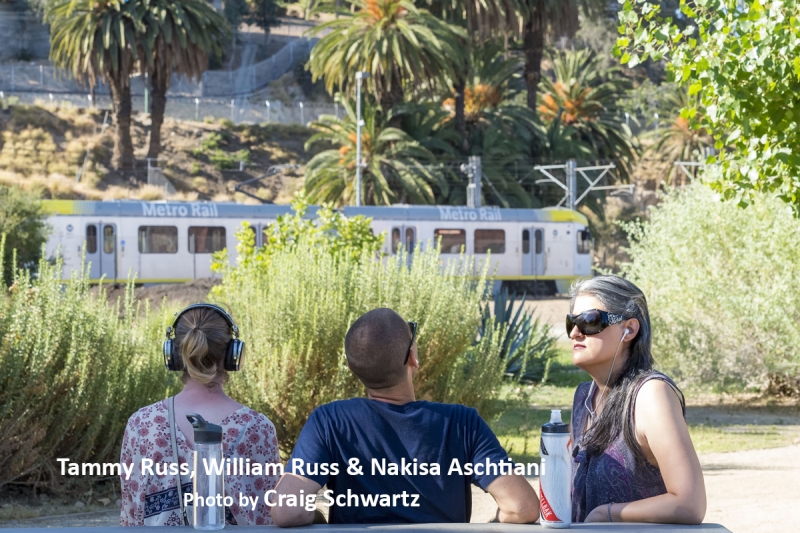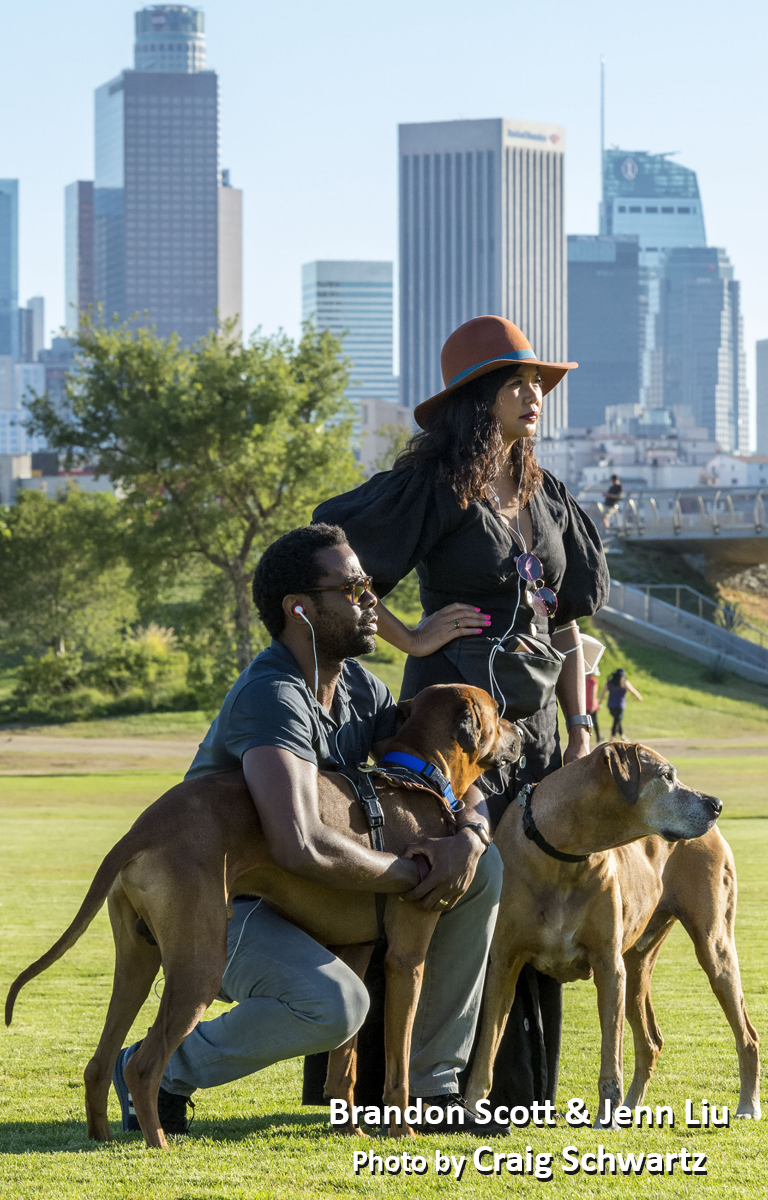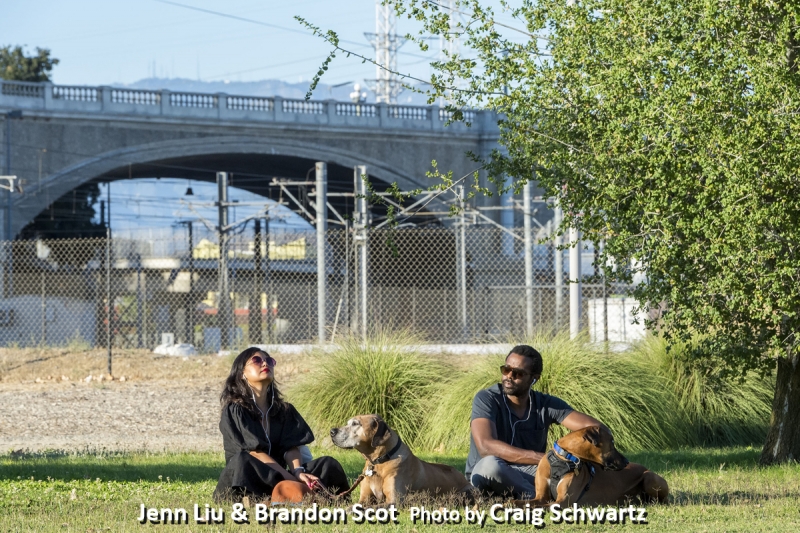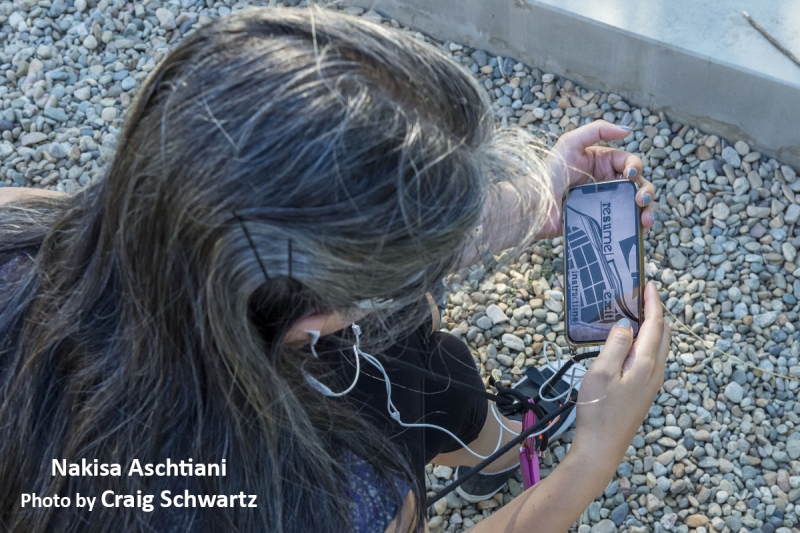Interview: Marike Splint Constantly Creating 32 ACRES & Other Site-Specific Experiences
Center Theatre Group, in association with UCLA School of Theater, Film & Television, presents 32 ACRES, an outdoor soundwalk through Los Angeles State Historic Park

Center Theatre Group, in association with UCLA School of Theater, Film and Television, presents 32 ACRES, an outdoor soundwalk through Los Angeles State Historic Park, now through September 29, 2021 during park hours (8am through sunset). Got the chance to chat with 32 ACRES creator Marike Splint on this unique interactive theatrical experience.
Thank you for taking the time for this interview, Marike!
You have been creating site-specific projects since 2010. What inspired you to pursue this untraditional route to producing plays?
I am originally from the Netherlands, where site-specific performance is more prevalent than here in the U.S. Some of the most interesting live works I have seen have been at festivals dedicated specifically to creating work outside of traditional theatre venues.
After completing my MFA in directing at Columbia University, I returned to the Netherlands and also began to create site-specific work. Initially maybe out of impatience: I just wanted to put up work, make stuff, and I didn't want to wait for the longer programming timelines that brick-and-mortar institutions usually have to adhere to.
But soon I realized my fascination for place was actually coming from a personal source - my notion of 'home' has always been fluid. As the daughter of a containership navigator and a mother who migrated from Tunisia to France, I was raised with an unusual blend of Tunisian food, Dutch matter-of-factness, French language and liberal Sephardic tradition. This translates into my artistic exploration of belonging in locations that challenge our concept of identity in relationship to place. As an artist, I am fascinated by our continuously evolving relationship to public space, and consequently by urgent themes of identity, migration and belonging. To me, the questions of how we encounter each other, how we see each other, and how we conceive of new notions of communality feel particularly urgent. I choose to work outside of conventional theatre buildings to address these questions in the actual places that conjure them: civic centers, public parks, produce markets, train stations, gas stations, and in the virtual global map of Google Earth.
 What criteria led you to choose Los Angeles State Historic Park for your current piece?
What criteria led you to choose Los Angeles State Historic Park for your current piece?
I don't want to spoil too much about the piece, but I see the Los Angeles State Historic Park as a site that represents many of the questions that resonate with me in the larger city of Los Angeles. On one hand it is a place with lots of history, but this is barely visible at the surface, you have to dig in to become aware of it. On the other hand, as a young park, it cautiously reaches towards the future, towards what it could become. There is promise in what it could be. I am interested in this tension between the past, present and future that is in the DNA of the site. It makes it a very rich place to create from, even if it may not look like a spectacular landmark at first sight.
What is your three-line pitch for 32 ACRES?
32 ACRES is an immersive geolocated soundwalk for the Los Angeles State Historic Park about how we, as a community, remember and forget in the wake of the year that we all just experienced. The park serves as the enigmatic canvas for a contemplative experience on the character of Los Angeles, its hidden histories and imagined futures, and the paradoxes of urban nature.
How did the co-production of Center Theatre Group and UCLA School of Theater, Film and Television come about for 32 ACRES?
 Center Theatre Group had approached me about making something audio driven in public space back in November, as we were looking ahead at the moment where audiences would be ready to experience performances again, but maybe not quite yet indoors with many people. Initially the idea was to create an MP3 track, which I have done before, but timing is always an issue in that format - it doesn't allow for different paces of walking.
Center Theatre Group had approached me about making something audio driven in public space back in November, as we were looking ahead at the moment where audiences would be ready to experience performances again, but maybe not quite yet indoors with many people. Initially the idea was to create an MP3 track, which I have done before, but timing is always an issue in that format - it doesn't allow for different paces of walking.
My team and I then began exploring other formats that the sound could live in, and proposed to build a geo-located app, where the location and movements of participants in the park would trigger the content. We set out to build this in a game engine, UNITY, using audio functionalities that are common to videogames, but applying them to the public space.
This game engine infrastructure somewhat changed the scope of the project. I also teach in the theater department at UCLA, and the School of Theater Film and Television is always interested in supporting innovative faculty projects. Moreover, CTG and TFT had partnered on projects before. So, it was natural for both institutions to partner again in support of this project.
Were you physically exploring the L.A. State Historic Park during the pandemic months?
I went to the park quite a lot during the pandemic. The parks of Los Angeles are what kept me sane during the quarantine, and more than ever I realized the importance of public green space in cities over the last year.
Did you take copious notes in exploring? Did any of your technical/creative collaborators accompany you in your on-site explorations?
 For an experience this, that takes the form of a walk, or a journey, the work really takes shape in the walking. It's not something you can design from your laptop - you have to be in the park and walk around.
For an experience this, that takes the form of a walk, or a journey, the work really takes shape in the walking. It's not something you can design from your laptop - you have to be in the park and walk around.
So, in the creation of the work, we walked around the park quite a bit ourselves. We also asked several people, including the park's landscape architect and a California Parks historian and archeologist, how they usually take people around the park. Where do they enter, what sites do they always want to pass? What do they see behind the surface of what the park currently looks like? The park's employees and rangers were also very helpful in providing information about the history of the park and the vegetation. Our research was the accumulation of all these different walks that began to layer on top of each other and started to reveal something more than what you would see at first sight.
Jonathan Snipes, the composer and sound designer, used only sound recordings from the park itself in his compositions. So even in sound it is site-specific.
What do you want your 32 ACRES audience to come out with as they finish your audio tour? More knowledgeable? More zen? Entertained?
Our attempt with 32 ACRES is to reflect on the moment we currently live in, to capture the zeitgeist. We are all emerging from a time of loss and isolation. Sometimes it seems as if the world looks the same, but the pandemic has drastically changed so many parts of our lives. I am asking how we, as a community, as a city, deal with this recent past. How do we remember? What are we trying to forget?
 In a way I see it as a diptych with YOU ARE HERE - a homebound travelogue, a work I made a year ago commissioned by La Jolla Playhouse. YOU ARE HERE is what I would now call an early-pandemic work, about the moment we all went into confinement. 32 ACRES is about what is at the other end of that, as we are beginning to explore our post-pandemic lives.
In a way I see it as a diptych with YOU ARE HERE - a homebound travelogue, a work I made a year ago commissioned by La Jolla Playhouse. YOU ARE HERE is what I would now call an early-pandemic work, about the moment we all went into confinement. 32 ACRES is about what is at the other end of that, as we are beginning to explore our post-pandemic lives.
Which of your past projects are you most proud of in overcoming its related obstacles?
The last year has catapulted new forms in theatre performance, and for both YOU ARE HERE and 32 ACRES we not only built the content of the experience, but also the technical infrastructure in which it can take place. We were not working at all with a regular production model or in a physical theatre; for both we had to build a virtual space for scratch to hold the experience. I have to credit my incredible team for that. Sound designer Jonathan Snipes and production designer Hana Kim designed an elaborate technical setup for YOU ARE HERE, which we performed live from my home over Zoom, incorporating several media source that were edited live during the performance. They also worked with me on 32 ACRES, and for this project the team was expanded with app developer Stewart Blackwood and Tatum Anderson, who did additional sound design and implementation. The combination of creative and technical skills of these collaborators is incredible.
How would you compare and contrast the various countries you've been in - as the most challenging or the smoothest to put on one of your productions?
The main observation I take away from working in different countries is the differences in public space, or the philosophy around public space, in each country. Having worked in Europe a lot, I find that there is a lot less public space in the USA, which often times (not for this project) makes it harder and more expensive to get permits to do something like this. The USA is also the only country in which we provide the audience with a liability waiver when they participate in my site-specific works. I think this has to do with a difference in general access to healthcare compared to Europe. When you work in public space, the work is undeniably tangled into the socio-political fabric of the city or country you are working in.
 On the other hand, in the Netherlands rain and cold weather was often a challenge. In Southern California, it is amazing to be able to put up outdoor work year-round.
On the other hand, in the Netherlands rain and cold weather was often a challenge. In Southern California, it is amazing to be able to put up outdoor work year-round.
What gives you more gratification: Receiving a standing ovation for one of your site-specific projects? Or seeing the lightbulb moment of a student figuring out one of your teachings?
I see my practice and teaching as very intertwined. Teaching my students and watching them work makes me a better artist. At the same time, being an active professional in the field makes me a better educator to them. Engaging in creating, research and teaching is an ideal balance for me as an artist.
What's in the near future for Marike Splint?
We have built brand new software for 32 ACRES, and it allows for an experience in public space that is quite unique in its possibilities. It's a form that seems very suitable for this in-between moment we are currently in as a theatre community. It is in-person, on-site, but it doesn't come with the challenges of large crowds in indoor venues. Me and my team are excited to further expand on what we have built, and do similar projects on other sites.
Thank you again, Marike! I look forward to experiencing your 32 ACRES.
 To download the free app, and get more information on this new uniquely enveloping outdoor soundwalk through Los Angeles State Historic Park, now through September 29, 2021; log onto www.32acresla.com
To download the free app, and get more information on this new uniquely enveloping outdoor soundwalk through Los Angeles State Historic Park, now through September 29, 2021; log onto www.32acresla.com
Los Angeles State Historic Park is located at 1245 N. Spring Street, Los Angeles CA, 90012
Comments
Videos

